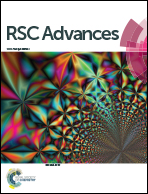Highly versatile p(MAc)–M (M: Cu, Co, Ni) microgel composite catalyst for individual and simultaneous catalytic reduction of nitro compounds and dyes†
Abstract
Poly(methacrylic acid) (p(MAc)) microgels were synthesized by inverse suspension polymerization and used as a template for copper, nickel, and cobalt nanoparticle preparation. Upon absorption of Co(II), Ni(II), and Cu(II) by p(MAc) microgels from related aqueous solutions, the metal ion laden microgels were treated with sodium borohydride (NaBH4) to obtain the corresponding metal nanoparticles within the p(MAc) network as p(MAc)–M (M: Co, Ni, Cu). The microgels and metal nanoparticle containing composites were visualized and analyzed by Optical Microscopy, SEM, and TEM analysis. Thermal properties and the metal nanoparticle content of the prepared composites were investigated by TG analysis. However, the exact amounts of metal nanoparticles entrapped within the microgels was calculated by AAS measurements after dissolution of the metal nanoparticles within p(MAc) the microgel composites by concentrated HCl acid treatment. The prepared p(MAc)–M composites were employed as a catalyst for the degradation of some organic dyes such as Eosin Y (EY), and methyl orange (MO), and reduction of nitro aromatic pollutants such as 2-nitrophenol (2-NP), 4-nitrophenol (4-NP), 4-nitroaniline (4-NA) to their corresponding amino phenols. More importantly, we report the simultaneous degradation of EY and 4-NP reduction catalyzed by p(MAc)–Cu microgel composites. Various parameters effecting the degradation of dyes and nitro compound reduction such as metal types, and their amounts, temperature and amount of reducing agent were investigated.


 Please wait while we load your content...
Please wait while we load your content...